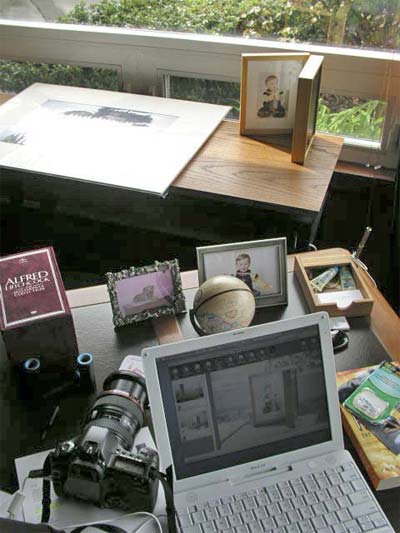Instant digital gratification?
I messed about some more with the software Canon provides with its 5D camera, Digital Photo Professional (DPP). You know the application with all those comedic spelling errors.
Well, I found more spelling errors, true, but I got to wondering about the little USB cable Canon provides with the camera that plugs into a receptacle under that silly flap on the side.
After installing DPP on my iBook, I plugged the camera in and switched the ‘Communications’ option on the Tools menu on the LCD from ‘Print/PTP’ (the default) to ‘PC Connect’. That really should read ‘iMac Connect’ but I’ll let it go. With the camera switched on, go to DPP->Tools->Start EOS Capture on the iBook and you are ready.
Take a snap in RAW format and, hey presto!, the picture appears on the iBook’s screen. It works as well in Jpg mode. You see the snap on a full screen where you can actually gauge sharpness, focus, exposure and so on, as opposed to the small LCD screen on the back of the camera where you mostly see your nose in the reflection.
For a studio photographer, whether taking product pictures or using live models, this strikes me as the bee’s knees in functionality. The pictures are automatically transferred from the camera’s card to the computer while all this is going on. Thus a smart pro could have his studio assistant view the screen shots and provide instant feedback allowing corrections to be made. After all, said assistant no longer has anything else to do as he’s not loading film any more. And you thought Polaroid invented instant gratification?

With the camera set to the lowest quality Jpg setting, a sharp picture pops on the screen in 3 seconds; with RAW it pops up blurred in 5 seconds and takes another 10 seconds to sharpen. There’s quite a bit of processinbg going on in this case and, let’s face it, my iBook’s 1.42 gHz processor isn’t the fastest on the planet. The timing with RAW + low quality Jpg is similar.
A separate panel on the iBook’s screen also appears allowing you to set many of the cameras settings using the keyboard, such as aperture, shutter, ISO, image quality. Most intriguingly, you can also enable a timer automating shots with stated intervals. Maybe astronomers will like this sort of thing?
The cable provided is ridiculously short – some eighteen inches – as to be unusable, but that’s nothing an extension cable cannot fix.
Postscript: I tried this set-up with a 15 foot long USB extension cable using my iMac G5 which has a 2 gHz Power PC processor, 2 gB of memory and very fast video processing. A sharp RAW image is displayed in 5 seconds, highest quality Jpg takes 3 seconds and lowest quality Jpg is around 1.5 seconds. These times suggest this would be an extremely capable studio installation as, by the time you have set the camera down to look at the monitor, the image will be there.